Chapter 3 - Excitable cells and Neuronal Signalling
1/22
There's no tags or description
Looks like no tags are added yet.
Name | Mastery | Learn | Test | Matching | Spaced |
|---|
No study sessions yet.
23 Terms
Membrane potential and the role of Na+ and K+ pump
Membrane Potential
i. The plasma membrane of all living cells has a membrane potential (polarized electrically)
ii. Separation of opposite charges across the plasma membrane
iii. Due to differences in concentration and permeability of key ions
All cells have a membrane potential → The outer covering (plasma membrane) of every cell has an electrical charge difference across it.
Why? → Because positive and negative charges are separated on the two sides of the membrane.
How? → This happens because certain ions (like sodium and potassium) are in different amounts inside vs outside the cell, and the membrane lets some pass through more easily than others.
👉 In short: A cell’s membrane acts like a tiny battery because ions are unevenly spread and the charges are separated.
The plasma membranes of all living cells have a membrane potential, meaning they are electrically polarized. This potential allows for cellular communication in excitable cells such as nervous tissue and muscle.
The term membrane potential quite simply refers to the difference in the electrical potential between inside and outside a cell.
When there is a difference in the relative number of cations (+) and anions (−) in the intracellular fluid (ICF; inside the cell) and the extracellular fluid (ECF; outside the cell), a separation of charges is created. Opposite charges tend to attract each other, whereas like charges tend to repel. Work is performed (energy expended) to separate opposite charges after they have come together
have been separated, the electrical force of attraction between them can be harnessed to perform work when the charges are permitted to come together again. Because separated charges have the potential to do work, a separation of charges across the membrane is called a membrane potential.
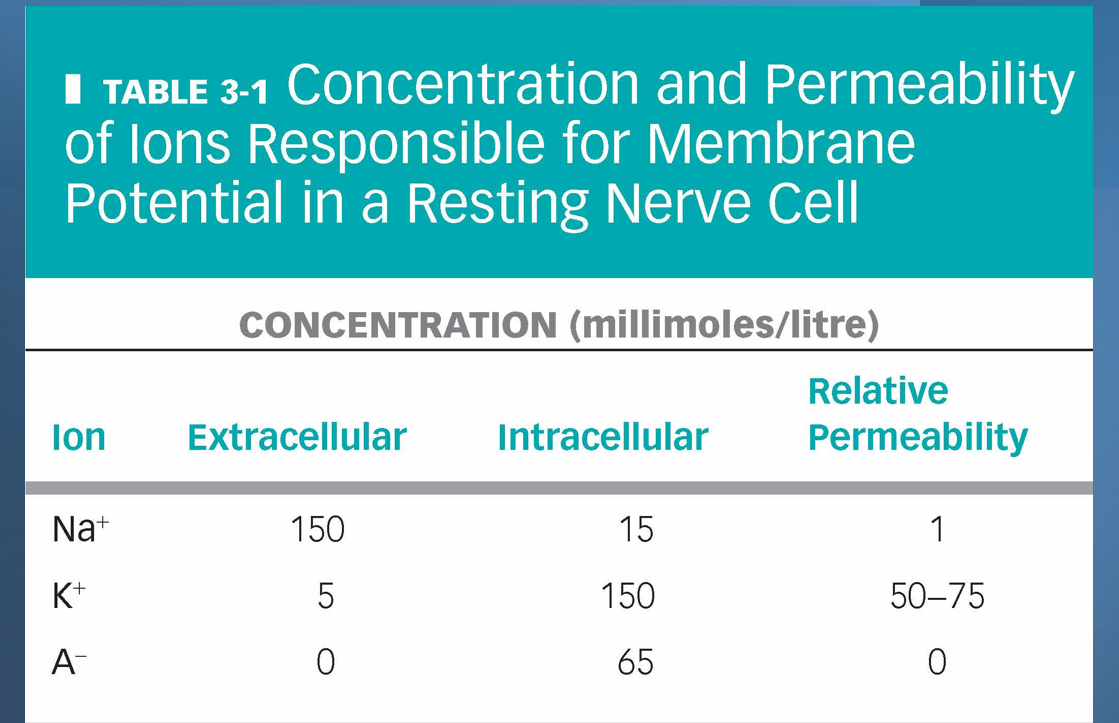
Membrane potetial and the role of Na+ and K+ pump
Breaking it down:
Na⁺ (Sodium)
High outside (150)
Low inside (15)
Membrane not very permeable to it (1)
K⁺ (Potassium)
Low outside (5)
High inside (150)
Membrane much more permeable to it (50–75 times more than Na⁺)
A⁻ (Large negative proteins/ions)
Only inside the cell (65)
None outside (0)
Cannot cross the membrane (0 permeability)
Simple meaning:
Sodium wants to go in (because it’s high outside).
Potassium wants to go out (because it’s high inside).
Negative proteins stay trapped inside.
Since the membrane lets potassium move much more easily than sodium, more positive charge leaks out (K⁺), leaving the inside negative compared to outside.
👉 That’s why nerve cells have a negative resting membrane potential.
Exam Question
what brings a nerve back to rest ——> primary active trasnport
gated channels ——→ voltage (Na, calcium)
—> 2) Chemically neurotransmitters
—> 3) Mechanically, pressure
—> 4) thermally
Describe the various changes in membrane potential
Nerve and muscle cells
Excitable cells
Have the ability to produce rapid, transient changes in their membrane potential when excited.
Resting membrane potential
Constant membrane potential present in cells of non-excitable tissues and those of excitable tissues when they are at rest.
vi. Effect of sodium-potassium pump on membrane potential
Makes a contribution to the membrane potential through its unequal transport of positive ions.
Nerve and muscle cells are called excitable cells because they can quickly change their membrane potential when stimulated (this is how nerves send signals and muscles contract).
Resting membrane potential is the steady, constant voltage across the membrane when the cell is not active (like the “baseline” charge difference).
Even non-excitable cells (like skin or liver cells) have a resting membrane potential, but they don’t use it to send signals.
👉 Think of excitable cells as “charged batteries” that can suddenly release energy when needed, while resting potential is the steady charge when the battery is just sitting.
The sodium-potassium pump moves ions unequally:
It pumps 3 Na⁺ out and 2 K⁺ in each cycle.
This means more positive charge leaves than enters, making the inside more negative compared to the outside.
So the pump helps maintain the resting membrane potential and keeps the charge difference stable.
👉 The pump acts like a tiny ion “bouncer,” kicking more positive charges out than it lets in, which helps keep the cell inside negative.
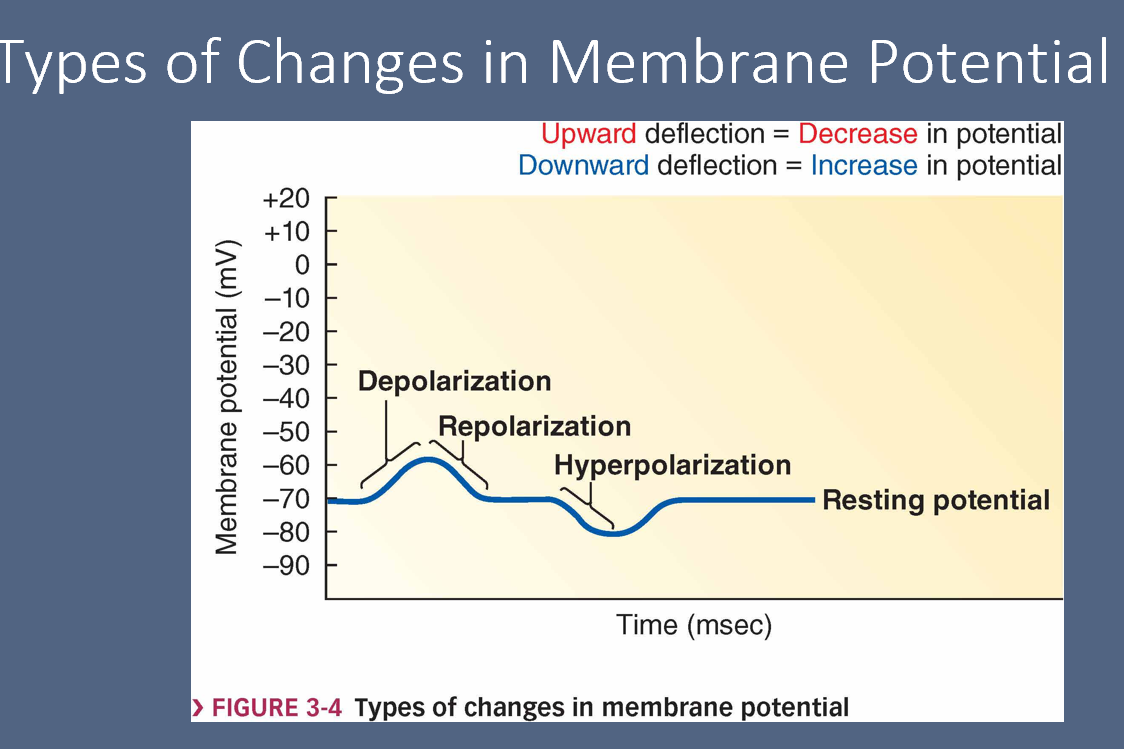
Neural Communication - Electrical states
A. Polarization
Any state when the membrane potential is other than 0mV.
B. Depolarization
Membrane becomes less polarized than at resting potential
C. Repolarization
Membrane returns to resting potential after having been depolarized
D. Hyperpolarization
Membrane becomes more polarized than at resting potential
A. Polarization
Think of this as the “normal charged state” of a neuron.
The inside of the cell is negative compared to the outside.
It just means the voltage (charge difference) is not zero.
Everyday analogy:
Imagine a magnet: it has a north pole and a south pole → that’s polarized.
If both sides were the same, it wouldn’t be a magnet anymore.
So, polarization = the cell is charged, with inside negative and outside positive.
B. Depolarization
The neuron gets less negative (closer to zero).
This happens when the neuron is starting to “fire” (send a signal).
Simple analogy:
Think of a toilet 🚽:
Resting potential = water ready in the tank.
Depolarization = flush → water rushes out fast (signal firing).
👉 So, depolarization = the neuron gets less negative inside, because sodium rushes in, and the cell starts sending its signal.
C. Repolarization
After firing, the neuron goes back to its resting state (back to being negative inside).
It’s like resetting the battery.
D. Hyperpolarization
The neuron becomes even more negative than usual.
This makes it harder for the neuron to fire right away again — like putting it in a “cool down” phase.
👉 Easy way to remember:
Polarized = charged.
Depolarize = firing up.
Repolarize = resetting.
Hyperpolarize = extra reset (too negative).
Graded potetnail - short distance, variable-strength, go a few mm and then die down, they are decremetnal beacuse they have a)leaky ions which makes it go back to resting potential. b)Cytploasmic resisatnce will killl this membrane change.
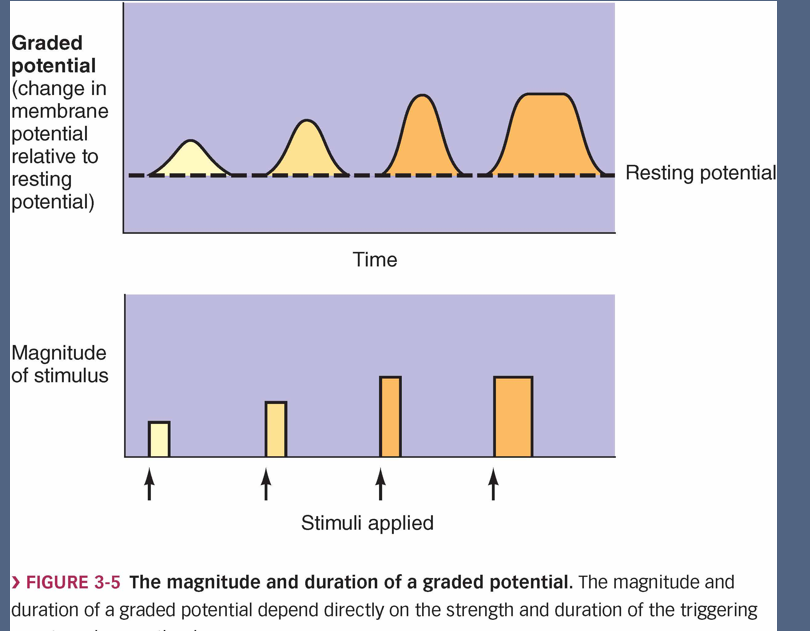
Neurons communicate via two different types of electrical signals:
A. Graded potential
B. Action potential
Neural Communication
Nerves and muscles are excitable tissues
Electrical signals are critical to their function,
1. What is a graded potential?
It’s a small, temporary change in the charge of a neuron’s membrane.
It happens when a stimulus (like a chemical, touch, or signal) opens ion channels.
It’s “graded” because the size of the change depends on how strong the stimulus
Occurs in small, specialzied region of the membrane
Magnitude continues to decrease
2. Key features of graded potentials:
Size matters: A stronger stimulus = a bigger change (slide 1 shows small → medium → big bumps).
They fade with distance: The further they spread, the weaker they get (slides 2 & 3 show this).
Short distance only: They only travel a few millimeters before dying out.
Can add up: If enough graded potentials stack up, they can trigger an action potential (the real nerve signal).
3. How they spread (slide 4):
At rest → neuron is polarized.
A stimulus opens sodium (Na⁺) channels → positive ions rush in at that spot → depolarization happens.
That spot becomes less negative than nearby spots.
Current flows from the depolarized spot into neighboring areas.
But some charge leaks out, so the effect gets weaker with distance (decremental spread).
4. Examples of graded potentials (slide 5):
Postsynaptic potentials → signals after neurotransmitters bind.
Receptor potentials → from sensory receptors (e.g., touch, smell).
End-plate potentials → at muscle-neuron junctions.
Pacemaker potentials → in heart cells, controlling heartbeat.
Simple analogy 🧃
Think of graded potentials like squeezing a water balloon:
A small squeeze → small ripple.
A big squeeze → big ripple.
But as the ripple moves across the balloon, it fades out.
If enough ripples build up → they can “trigger” a bigger reaction (like popping the balloon = action potential).
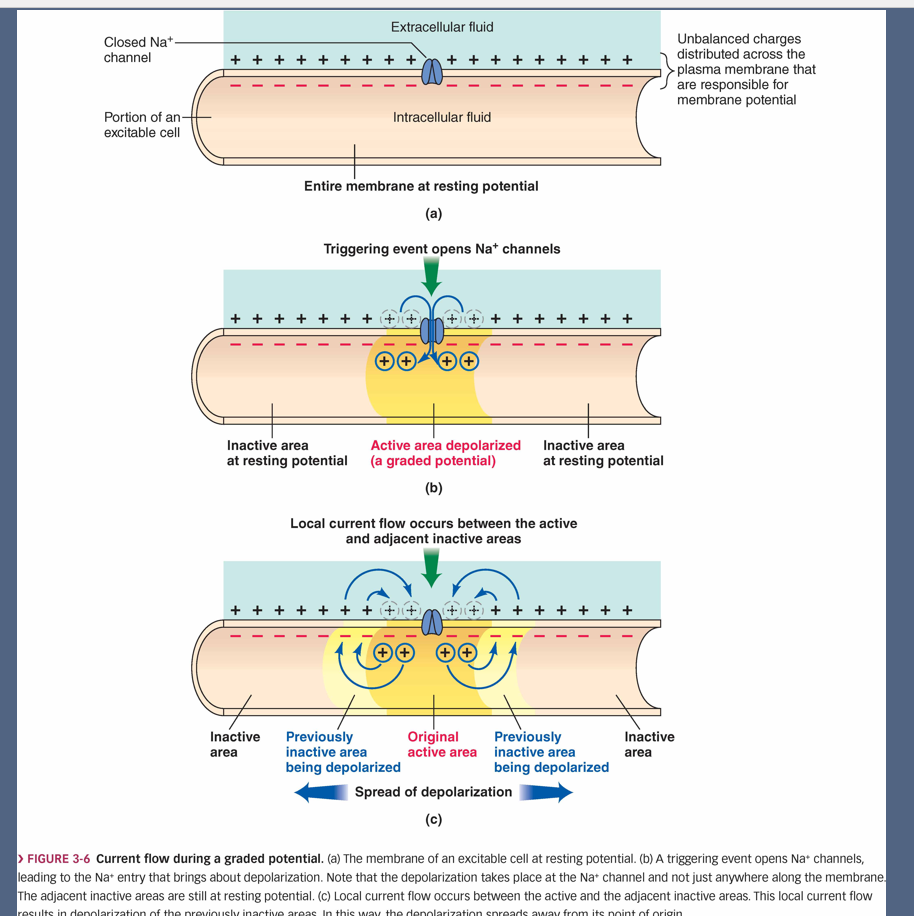
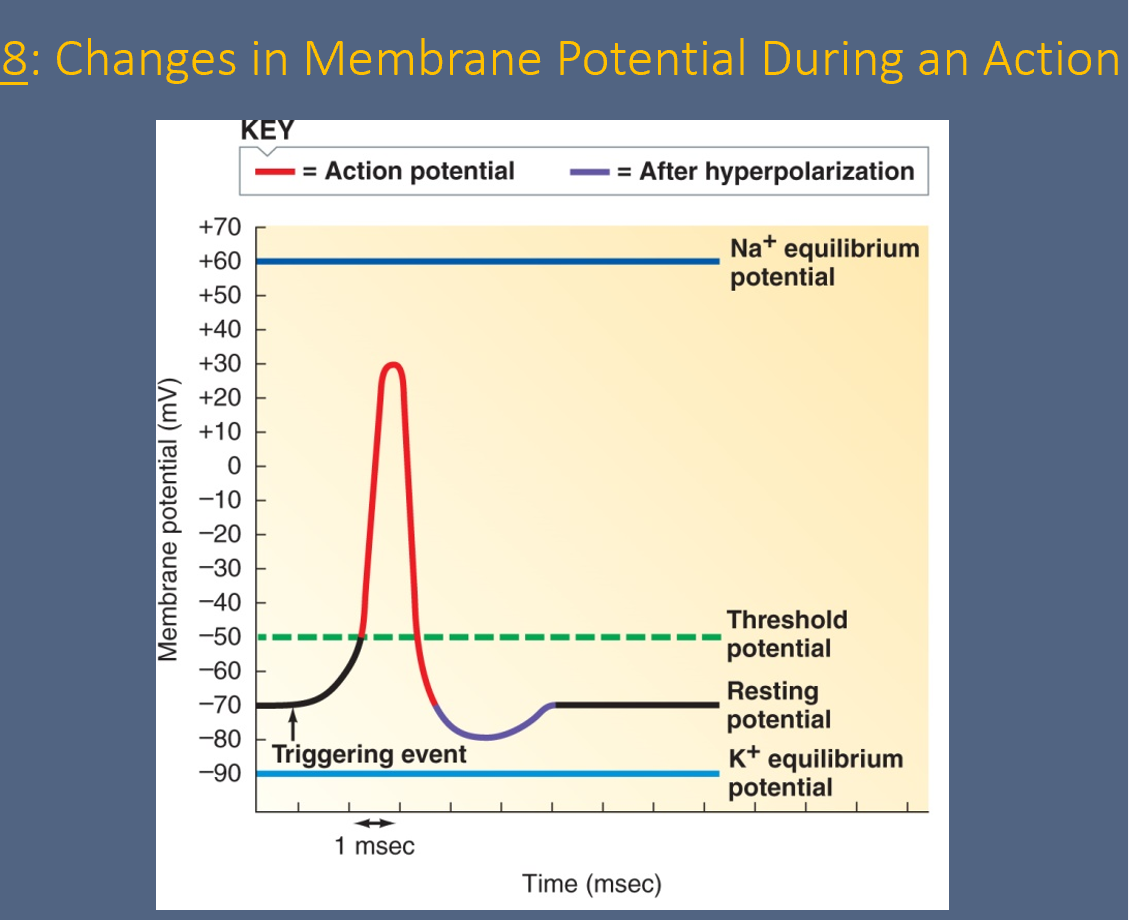
Neural Communication
B. Action potential
a. Bref, rapid, large (100mV) changes
b. Involves only a small portion of the total excitable cell memrbane
c. do not decrease in strength
Exam Question
An action potential is always the same strength —> Choose a 100
How long does the whole thing takes ——> 1 milliosecond
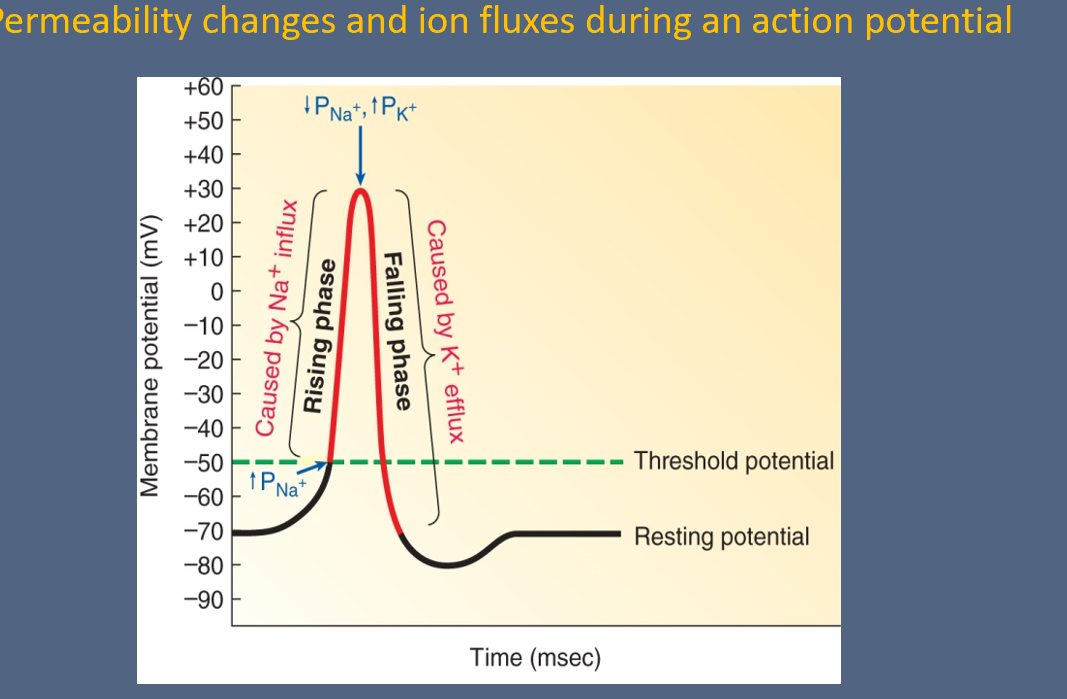
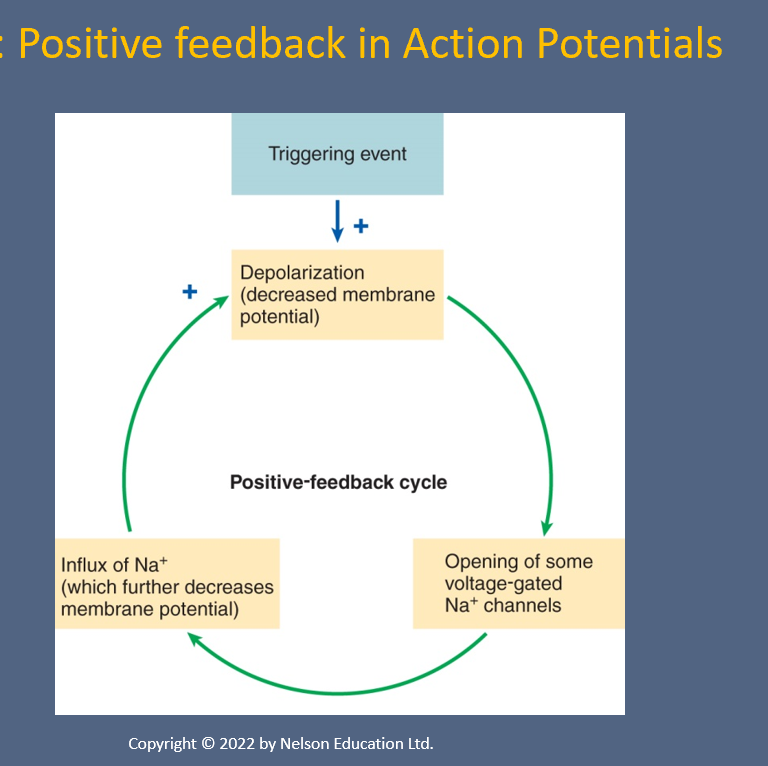
Action potentials
When the membrane reaches threshold potential
Flow of sodium ions into the ICF reverses the membrane potential from -70mV to +30 mV.
Flow of potassium ions into the ECF restores the membrane potential to the resting state.
1. What triggers an Action Potential
The neuron starts at resting potential (–70 mV).
If a strong enough stimulus makes the cell reach threshold (about –55 mV)…
Sodium (Na⁺) channels open, sodium rushes in, and the inside flips from negative to positive (+30 mV).
This is depolarization.
2. How the signal resets
After the peak, potassium (K⁺) channels open, K⁺ rushes out.
This makes the inside negative again = repolarization.
Sometimes it goes a bit too negative = hyperpolarization.
Finally, the Na⁺/K⁺ pump restores normal ion balance (Na⁺ out, K⁺ in).
3. Special features of Action Potentials
Positive feedback: When sodium enters, it triggers more sodium channels to open, making the signal stronger (like a snowball effect).
Double gating of sodium channels:
They have 2 gates:
Activation gate → opens quickly at threshold.
Inactivation gate → closes slowly to stop Na⁺ entry.
Delayed potassium opening: K⁺ channels open slower than Na⁺ channels, so repolarization happens after depolarization.
Undiminished signal: Unlike graded potentials, action potentials don’t fade — they travel the full length of the axon with the same strength.
4. Role of Na⁺/K⁺ Pump
Gradually resets the ion distribution.
Pumps Na⁺ back out to ECF, K⁺ back in to ICF.
Keeps the neuron ready for the next action potential.
🚀 Analogy:
Think of it like flushing a toilet:
Push handle = stimulus → threshold reached.
Water rushes out = sodium in (depolarization).
Tank refills = potassium out + Na⁺/K⁺ pump working (repolarization + reset).
Once reset, it’s ready for the next flush (next action potential
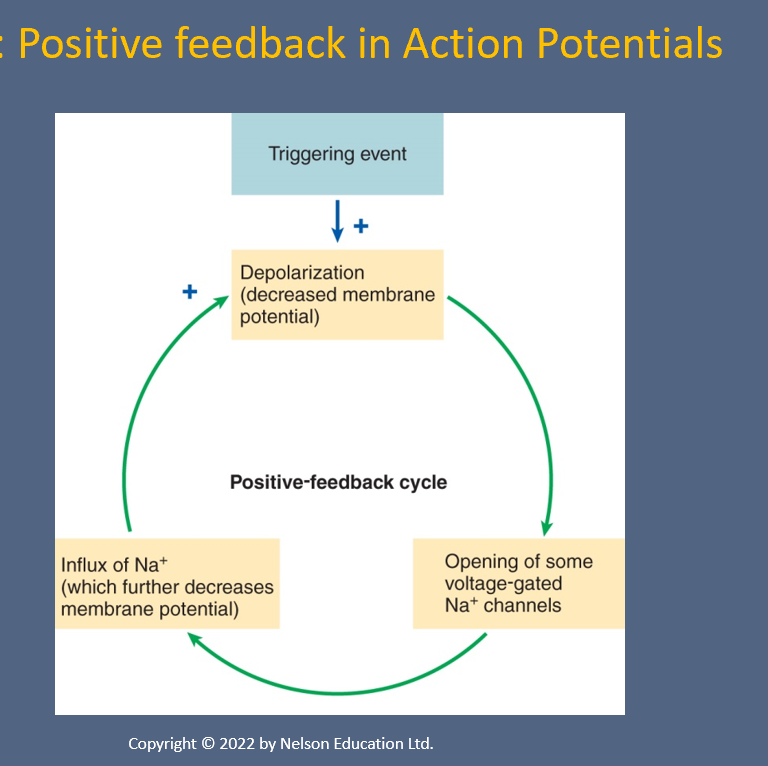
ECF VS ICF
ECF (Extracellular Fluid)
Definition: The fluid found outside of the body's cells.
Composition: Consists of blood plasma (intravascular fluid), interstitial fluid (the fluid that surrounds cells), and transcellular fluid.
Role: Acts as a medium for transporting substances to and from cells.
Electrolytes: High in sodium, chloride, and bicarbonate ions.
ICF (Intracellular Fluid)
Definition: The fluid that is located within the cells.
Composition: Enclosed by the plasma membrane of each cell.
Role: Contains the cellular machinery and provides a medium for the cell's internal environment.
Electrolytes: High in potassium, phosphate, and magnesium ions.
Key Differences
Location: ICF is inside cells, while ECF is outside cells.
Volume: ICF makes up about two-thirds of the body's total water, while ECF makes up about one-third.
Major Ions: Sodium is the main ion in ECF, whereas potassium is the main ion in ICF.
Barriers: A cell membrane separates the ICF and ECF, while a capillary membrane separates plasma from interstitial fluid within the ECF.
Role of the activation and inactivation gates of the sodium channels
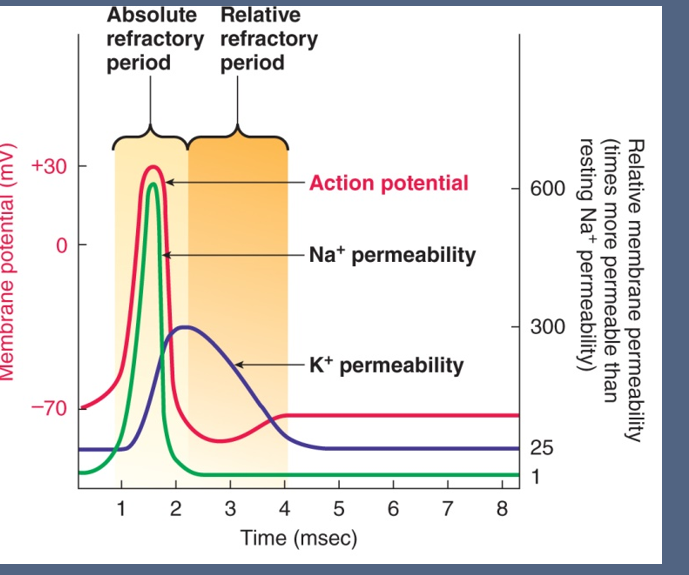
Refractory period and its significance
A. Absolute refractory period
b. Relative refractory period
Refractory period
Period of time following an action potential
Marked by decresed excitability
Types —> Absolute and Relative
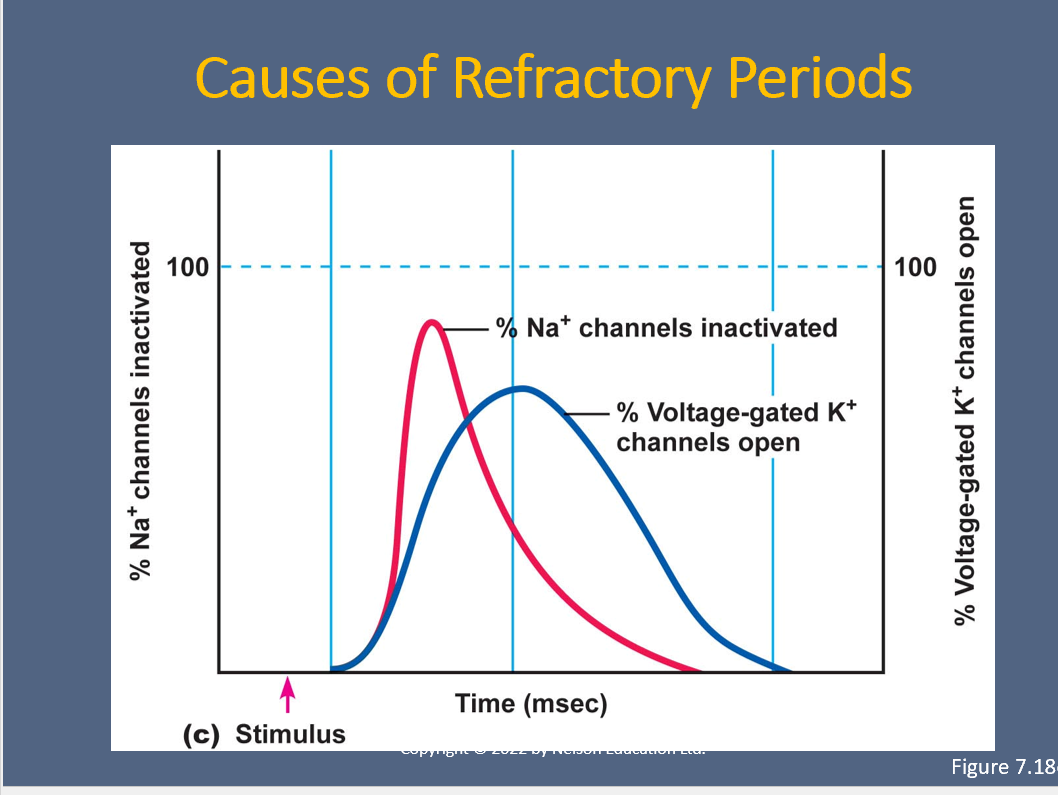
Absolute refractory period
Spans all of depolarization and most of the repolarization phase
Second action potential cannot be generated
Sodium gates are inactivated
Absolute Refractory Period
Happens during all of depolarization and most of repolarization.
Sodium (Na⁺) channels are inactivated (their inactivation gates are shut).
No new action potential can start, no matter how strong the stimulus.
👉 It’s like a toilet that’s flushing 🚽 — you can’t flush it again until the cycle is finished.
Relative refactory period
Spans last part of repolarization phase and hyperpolarization
Second action potetnial can be generted — with a strong stimulus
Sodium gates closed
Few potassium channels still open
Happens during the end of repolarization and hyperpolarization.
Sodium channels are closed but can reopen.
Potassium (K⁺) channels are still open.
A new action potential can happen, but only if the stimulus is stronger than normal.
👉 It’s like trying to flush a toilet while the tank is still filling — you need extra force.
Consequences of Refractory periods
. Why refractory periods matter
All-or-none principle: Once an action potential starts, it always goes full force — you can’t start a second one right in the middle.
One-way direction: Action potentials only move forward down the axon. They don’t bounce back because the area behind is still in refractory period.
4. Graph meaning (first image)
Red line: Sodium channels inactivated → Absolute refractory period.
Blue line: Potassium channels open → Relative refractory period.
✅ So in short:
Absolute refractory = no chance of firing again.
Relative refractory = possible, but needs stronger push.
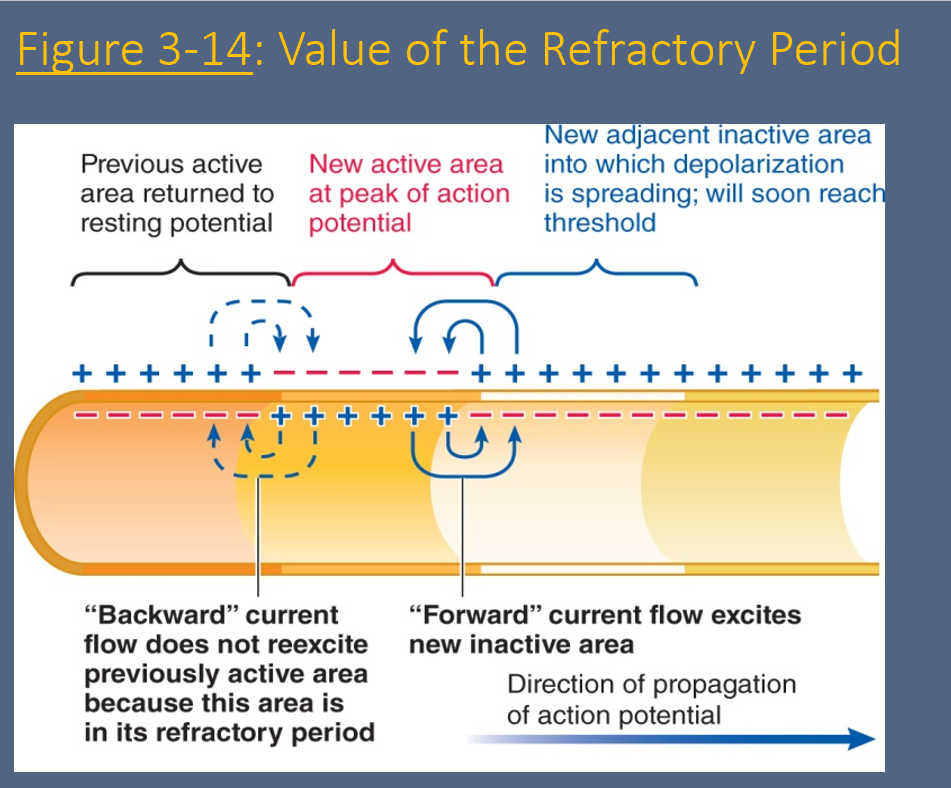
Structure of a typical neuron
1. Basic parts of a neuron
Cell body (soma):
The “main office” of the neuron.
Has the nucleus and keeps the neuron alive.
Dendrites:
The “antennae.”
Receive signals from other neurons and bring them into the cell body.
Axon:
The “wire” of the neuron.
Carries the signal (action potential) away from the cell body to other cells.
2. Special parts of the axon
Axon hillock:
The “trigger zone.”
Where action potentials start if the signal is strong enough.
Collaterals:
Side branches of the axon.
Let the neuron send signals to multiple places at once.
Axon terminals:
The “output zone.”
Release neurotransmitters (chemical messengers) to pass the signal to the next cell (like neurons, muscles, or glands).
3. Propagation of action potentials
Action potentials start at the axon hillock.
They travel down the axon (like an electrical wave).
When they reach the axon terminals, neurotransmitters are released to communicate with the next cell.
👉 Super simple analogy:
Dendrites = ears (listen).
Cell body = brain (decides).
Axon = mouth + arm (sends signal out).
Axon terminals = hands giving the message (release neurotransmitters).
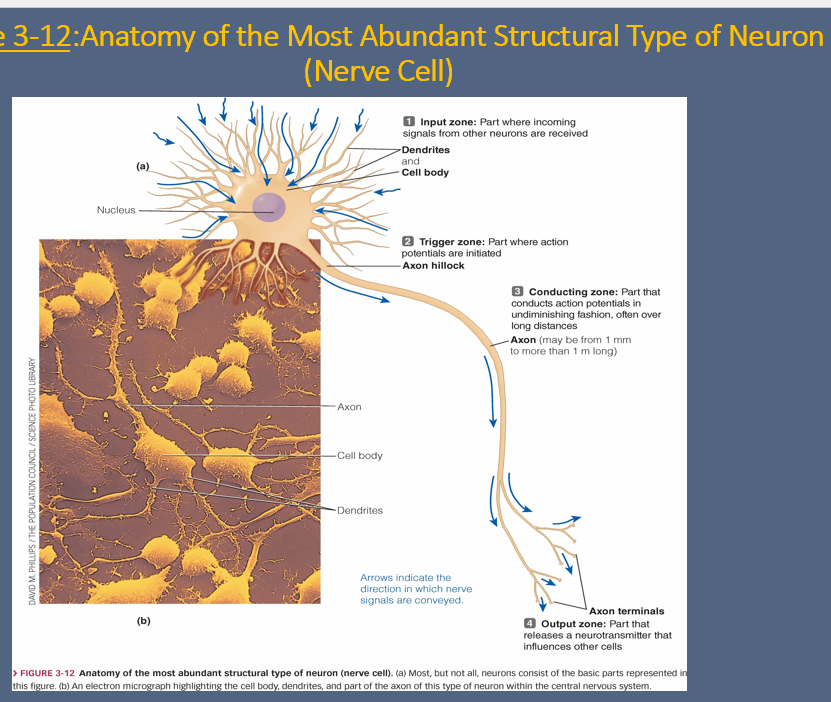
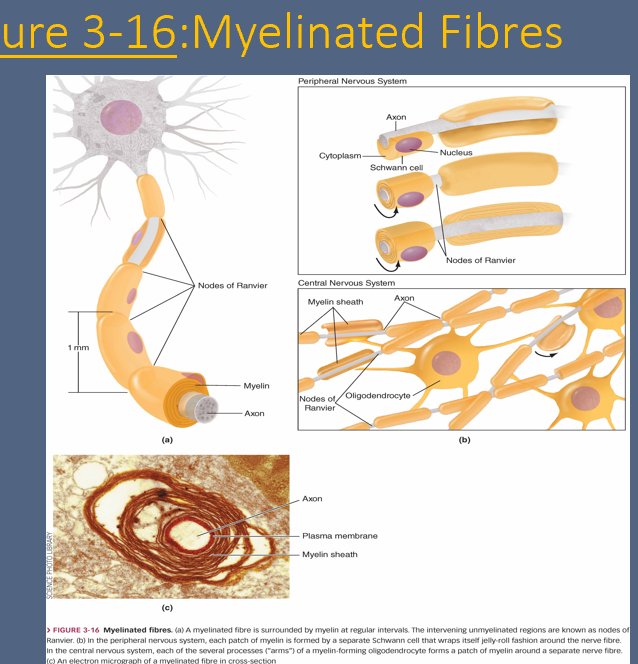
Difference between myelinated and unmyelinated fibers
3. Myelin Details
Made mostly of lipids (fatty substance).
CNS (brain & spinal cord): myelin made by oligodendrocytes.
PNS (nerves outside CNS): myelin made by Schwann cells.
Myelinated fibers
Have myelin sheath (fatty insulation around the axon).
Conduction type: Saltatory conduction (signal jumps from one Node of Ranvier to the next).
Speed: Very fast (about 50× faster than unmyelinated).
Energy use: More efficient → fewer ion exchanges needed only at nodes.
Found in: Most motor neurons, sensory neurons, and long-distance pathways.
Made by:
Oligodendrocytes in CNS
Schwann cells in PNS
🔹 Unmyelinated fibers
No myelin sheath (axon is bare).
Conduction type: Contiguous conduction (signal spreads step-by-step along the entire axon).
Speed: Slow.
Energy use: Less efficient → lots of ion exchanges needed along the whole membrane.
Found in: Some pain fibers and short local circuits.
👉 Analogy:
Myelinated fiber = express train 🚄 (stops only at major stations → nodes).
Unmyelinated fiber = local bus 🚌 (stops at every block → slow).
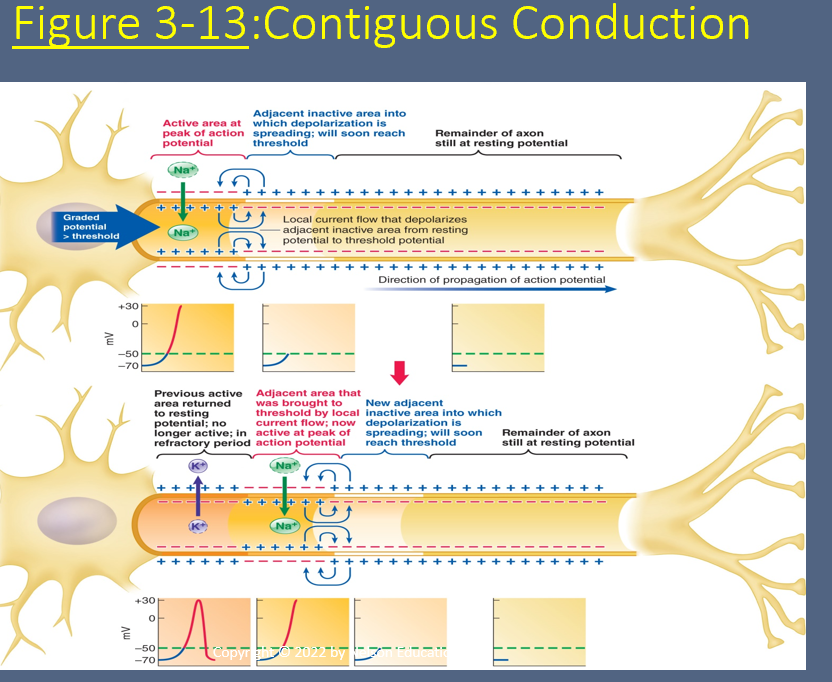
Difference between contiguous and saltatory conduction
1. Contiguous Conduction
Happens in unmyelinated axons (no insulation).
The action potential moves step by step along the entire length of the membrane.
It’s slower, because every tiny section of the axon has to depolarize and repolarize.
👉 Analogy: Like walking barefoot across hot sand — step by step, you touch every spot.
🔹 2. Saltatory Conduction
Happens in myelinated axons (covered with myelin, a fatty insulation).
Myelin blocks current from leaking out.
The action potential jumps from one exposed gap (Node of Ranvier) to the next.
This makes it much faster — about 50 times faster than contiguous conduction.
👉 Analogy: Like hopping across stepping stones in a river — you skip the spaces in between.
Saltatory Conduction = "Jumping Conduction"
Action potentials jump from one Node of Ranvier (gap in myelin) to the next.
Because of the myelin insulation, the impulse doesn’t need to travel step-by-step along the whole axon.
Why it’s faster
In unmyelinated axons: the signal must move through every section → slow.
In myelinated axons: the signal skips over myelinated areas → very fast (about 50x faster).
Myelin
What it’s made of: mostly fat (lipids) → works like electrical insulation.
Who makes it:
Oligodendrocytes → in the CNS (brain & spinal cord).
Schwann cells → in the PNS (nerves outside brain & spinal cord).
👉 Super simple analogy:
Imagine running across stepping stones in a river:
If there are no stones → you must walk slowly through every bit of water (unmyelinated).
If there are stones → you jump quickly from stone to stone (myelinated, saltatory conduction).
Example of a demyelinating disease
Multiple Sclerosis (MS)
An autoimmune disease → the body’s immune system attacks the myelin sheath in the CNS (brain & spinal cord).
Effect: Myelin is destroyed, leaving exposed axons.
Conduction changes:
Action potentials slow down.
In severe cases, they stop completely because saltatory conduction can’t happen.
Symptoms:
Muscle weakness
Vision problems
Loss of coordination and balance
Fatigue
Numbness/tingling
Other examples of demyelinating diseases:
Guillain-Barré Syndrome (GBS): affects the PNS, often triggered by infection.
Charcot-Marie-Tooth disease: genetic, affects PNS myelin.
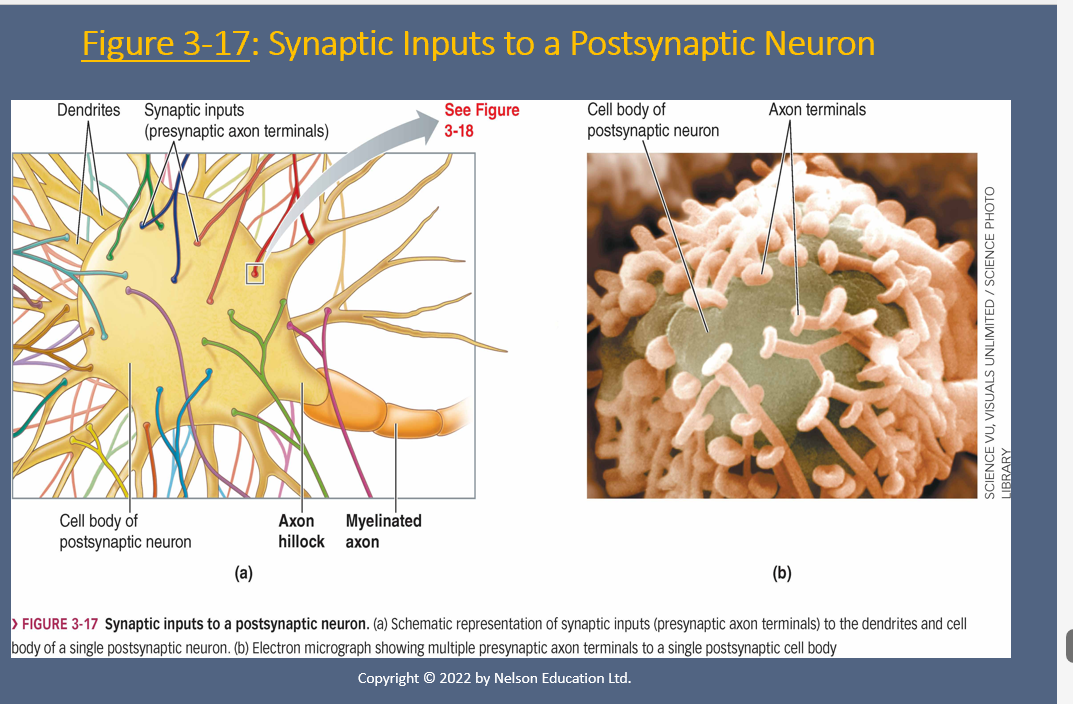
Functional anatomy of chemical synapses
Anatomy of a Synapse
Presynaptic neuron → the neuron sending the message.
Synaptic knob (axon terminal) → the end of the presynaptic neuron that contains little “bubbles.”
Synaptic vesicles → those bubbles, filled with neurotransmitters (chemical messengers).
Synaptic cleft → the tiny gap between the two neurons.
Postsynaptic neuron → the neuron receiving the message.
🔹 How it works (step by step)
Action potential arrives at the presynaptic knob.
This causes vesicles to release neurotransmitters into the synaptic cleft.
Neurotransmitters cross the cleft and bind to receptors on the postsynaptic neuron.
This may start a new graded potential or even an action potential in the postsynaptic neuron.
🔹 Picture meaning (Figure 3-17)
Left: Shows many presynaptic neurons making contacts (synaptic inputs) with one postsynaptic neuron’s dendrites and cell body.
Right: Real microscope image — you can see multiple axon terminals from different presynaptic neurons connecting to a postsynaptic cell body.
👉 Analogy:
Think of it like texting 📱:
Presynaptic neuron = sender’s phone.
Synaptic vesicles = the text messages.
Synaptic cleft = the internet connection gap.
Postsynaptic neuron = receiver’s phone.
The signal gets passed along, one phone to the next!
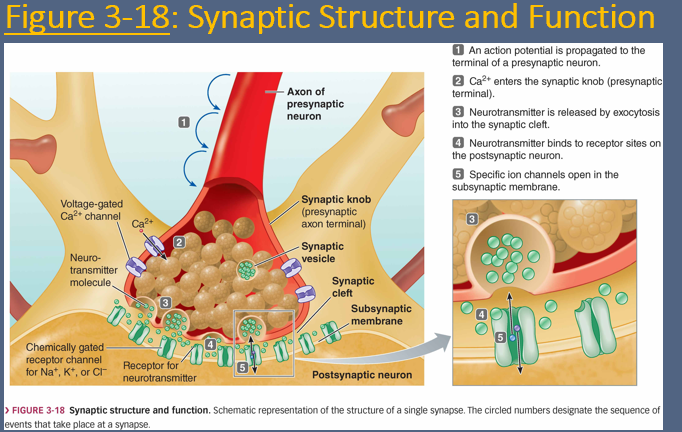
Steps of Synaptic Transmission
Action potential arrives
The signal (AP) travels down the axon and reaches the presynaptic knob (axon terminal).
2⃣ Calcium (Ca²⁺) enters
Voltage-gated Ca²⁺ channels open.
Ca²⁺ ions rush into the presynaptic knob.
3⃣ Neurotransmitter release
The rise in Ca²⁺ makes vesicles (little sacs) fuse with the membrane.
Neurotransmitters are released into the synaptic cleft by exocytosis.
4⃣ Binding to receptors
Neurotransmitters cross the synaptic cleft.
They bind to receptor proteins on the postsynaptic membrane.
5⃣ Ion channels open
This causes specific ion channels (Na⁺, K⁺, or Cl⁻) to open in the postsynaptic neuron.
Depending on the neurotransmitter, this can excite or inhibit the postsynaptic neuron.
🔹 Key point:
Synapse = electrical signal → chemical signal → electrical signal again.
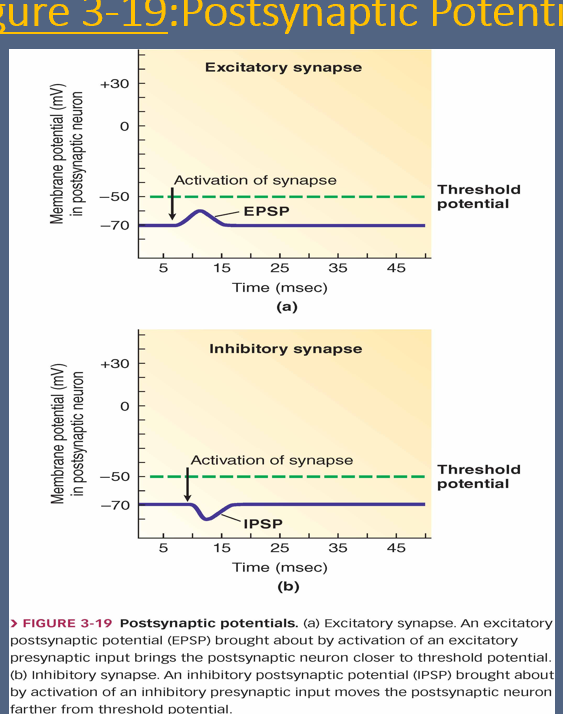
Signal transduction mechanisms at synapses:
1) Excitatory synapses
2) Inhibitory synapses
3) Synaptic delay
1) Excitatory Synapses (EPSPs – excitatory postsynaptic potentials)
What happens: Neurotransmitter (like glutamate) opens Na⁺ channels on the postsynaptic neuron.
Effect: More Na⁺ enters than K⁺ leaves → inside becomes less negative (depolarized).
Result: Brings the neuron closer to threshold, making it more likely to fire an action potential.
👉 Think: Green light 🚦 → GO signal for the neuron.
🔹 2) Inhibitory Synapses (IPSPs – inhibitory postsynaptic potentials)
What happens: Neurotransmitter (like GABA or glycine) opens Cl⁻ channels (Cl⁻ in) or K⁺ channels (K⁺ out).
Effect: Inside becomes more negative (hyperpolarized).
Result: Moves the neuron further from threshold, making it harder to fire an action potential.
👉 Think: Red light 🚦 → STOP signal for the neuron.
🔹 3) Synaptic Delay
What happens: There’s a tiny pause (about 0.5–1 ms) between the arrival of the action potential in the presynaptic neuron and the start of the postsynaptic potential.
Cause: Time is needed for neurotransmitter release, diffusion across the synaptic cleft, and receptor activation.
Result: Synapses are slower than direct electrical conduction.
👉 Think: Like a short pause when passing a message from one person to another in a game of telephone.
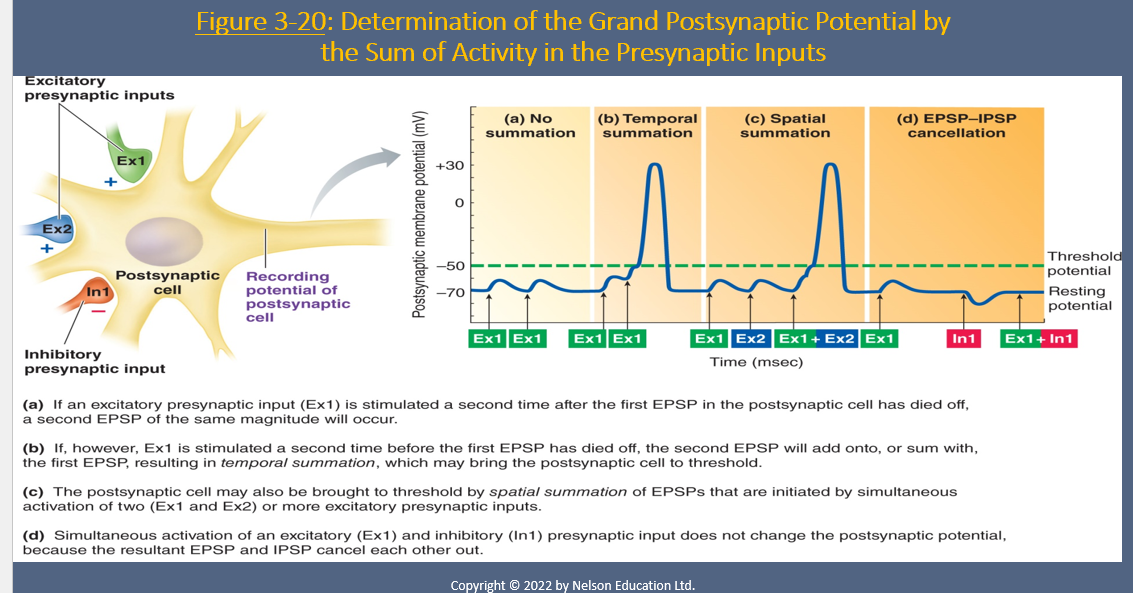
Neural summation:
a. Temporal summation
b. Spatial summation
“Temporal” = time.
One presynaptic neuron fires repeated signals in quick succession.
Each EPSP adds onto the previous one (before it fades away).
Together, they may reach threshold and trigger an action potential.
👉 Analogy: Like tapping a swing 🎠 again and again quickly → each push adds up, making it go higher.
🔹 b) Spatial Summation
“Spatial” = space / location.
Multiple different presynaptic neurons fire at the same time.
Their EPSPs add together on the postsynaptic neuron.
If the sum crosses threshold, an action potential fires.
👉 Analogy: Two friends pushing a swing at the same time → the pushes combine to move it higher.
Key Point
EPSPs (excitatory) and IPSPs (inhibitory) can also cancel each other out (like shown in part d of the figure).
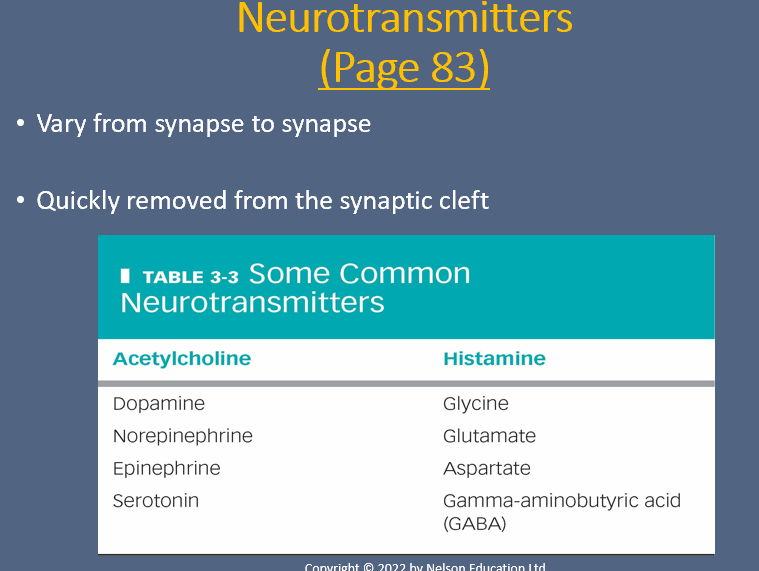
Effect of drugs (cocaine), diseases (Parkinson’s disease), infection (tetanus) on Synaptic transmission
1. Cocaine (drug)
Effect: Blocks the reuptake of dopamine at presynaptic terminals.
Result: Dopamine stays longer in the synaptic cleft → prolonged stimulation of the postsynaptic neuron.
Outcome: Intense feelings of reward and pleasure → leads to addiction.
👉 Like keeping the “happy signal” ON without turning it off.
🔹 2. Parkinson’s disease (neurodegenerative disease)
Effect: Loss of dopamine-producing neurons in the brain.
Result: Too little dopamine in motor control pathways.
Outcome: Muscle rigidity, tremors, difficulty starting movements.
👉 Like having too few signals in movement circuits → brain can’t properly tell muscles when to move.
🔹 3. Tetanus toxin (infection)
Effect: Blocks the release of inhibitory neurotransmitter GABA from presynaptic neurons.
Result: No inhibition of motor neurons → they fire uncontrollably.
Outcome: Continuous muscle contraction → spasms and lockjaw.
👉 Like cutting the brakes in a car → only “go” signals, no “stop.”
✅ Summary:
Cocaine = too much dopamine signal (overstimulation).
Parkinson’s = too little dopamine signal (understimulation).
Tetanus toxin = loss of inhibition (uncontrolled muscle activity).
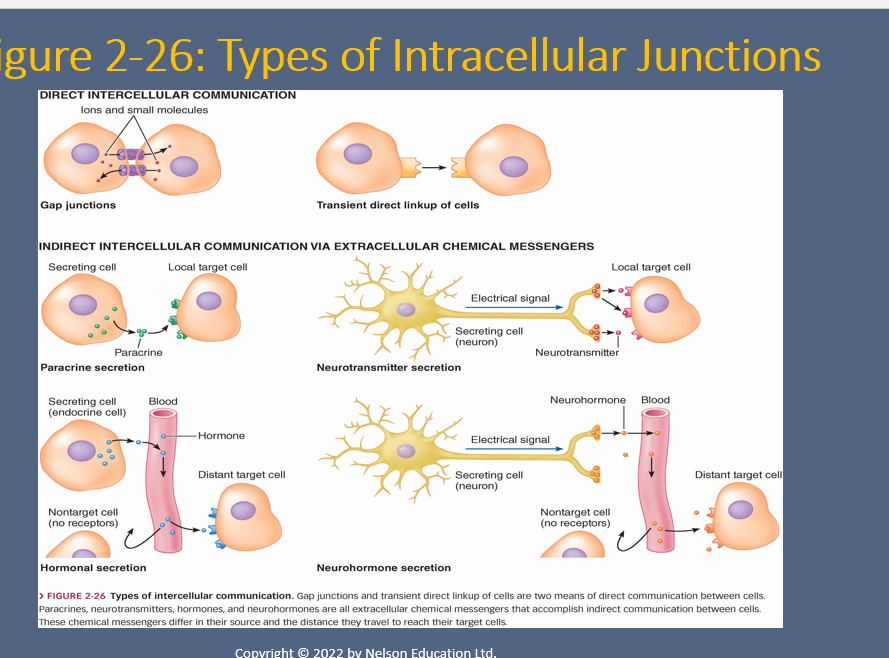
Various chemical messengers: (Pages 51 to 53)
A. Paracrine
B. Autocrine
C. Neurocrine
1. Neurotransmitter
2. Neuromodulator (are primarily neuropeptides)
3. Neurohormone
D. Cytokines
E. Hormones
1. Autocrines
Chemicals that act on the same cell that secreted them.
👉 Example: A cell releasing a growth factor that stimulates itself.
🔹 2. Paracrines
Chemicals that act on neighboring cells in the same tissue.
👉 Example: Histamine released during inflammation affecting nearby cells.
🔹 3. Neurocrines (released by neurons)
a) Neurotransmitters – fast, act across synapses.
Example: Acetylcholine, dopamine, GABA.
b) Neuromodulators (neuropeptides) – slower, longer-lasting effects.
Example: Endorphins (natural painkillers).
c) Neurohormones – hormones released by neurons into the blood.
Example: Vasopressin, oxytocin.
🔹 4. Hormones
Secreted by endocrine glands into the bloodstream.
Can act far away from where they were released.
Types:
Hydrophilic (water-loving): can’t cross membranes, act on surface receptors.
👉 Example: Insulin.Lipophilic (fat-loving): can cross membranes, act on intracellular receptors.
👉 Example: Steroid hormones like cortisol.
🔹 5. Cytokines
Released by immune cells and some non-immune cells.
Help with immune responses, inflammation, and cell communication.
👉 Example: Interleukins, interferons.
✅ Summary:
Autocrine → acts on itself.
Paracrine → acts on nearby cells.
Neurocrine → from neurons (neurotransmitters, neuromodulators, neurohormones).
Hormones → travel in blood (hydrophilic vs lipophilic).
Cytokines → immune system messengers.